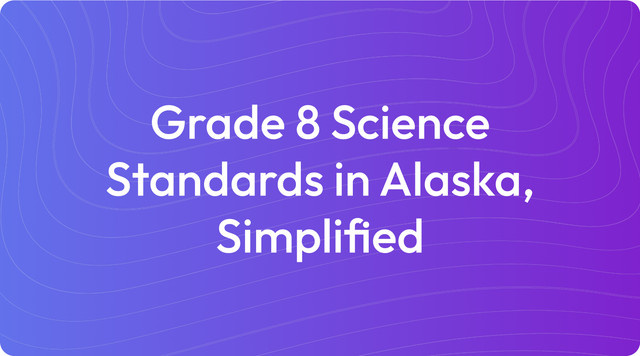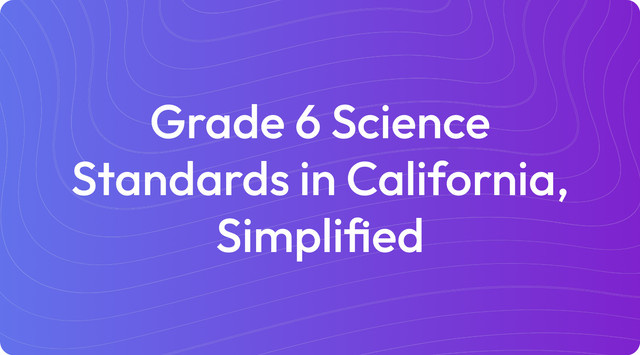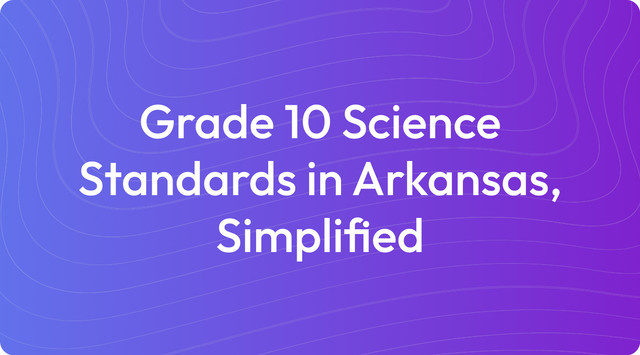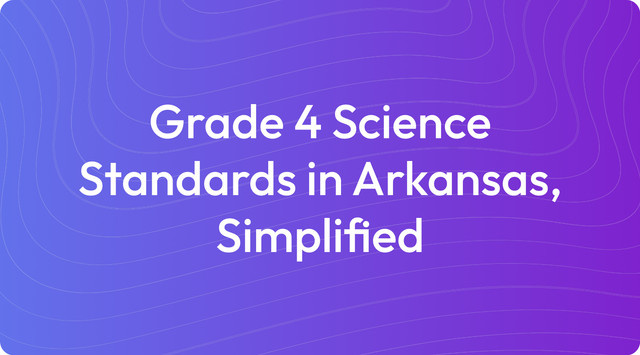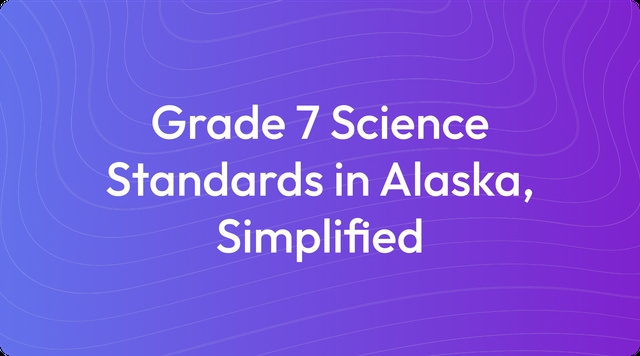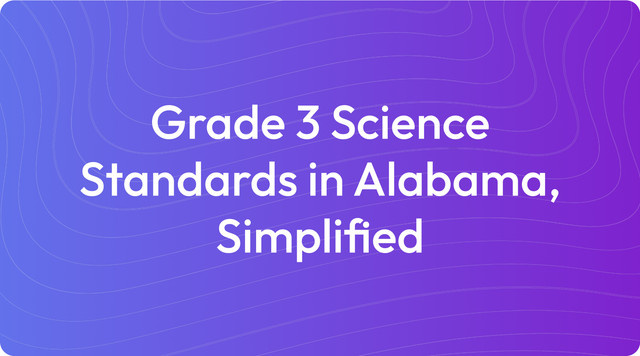Grade 5 Science Standards in Alaska, Simplified
Grade 5 science standards in Alaska explore matter, Earth’s systems, and ecosystem interactions. See what’s included—read more on TeachShare!
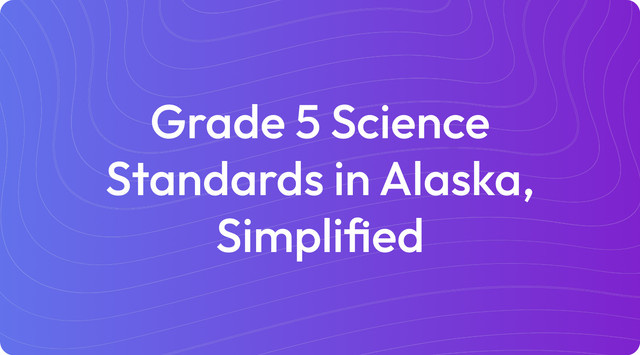
Working with educational standards is a core part of teaching, but it can often feel complex. We recognize the effort it takes to align curriculum with specific state requirements. Our goal is to offer clear, practical resources that help you build effective lesson plans that meet these learning goals.
Education standards are a set of clear learning goals that specify what students are expected to learn at each grade level. For teachers, this means you have a consistent framework for instruction without being told exactly how to teach. For instance, Alaska's Grade 5 science standards require students to model that matter is made of particles, leaving the choice of activity—like drawing diagrams or building physical models—up to you.
What Are Grade 5 Science Standards in Alaska?
The Grade 5 Science Standards for Alaska, adapted from the Next Generation Science Standards (NGSS), focus on developing a deeper understanding of Life Science, Physical Science, Earth and Space Science, and Engineering Design. These standards emphasize hands-on investigations and real-world problem-solving, helping you guide students as they use data and models to explore scientific concepts. Below is an overview of the standards for this grade level:
Grade 5 Science Standards in Alaska
1. Physical Science (PS): Matter and Energy
Standard 5-PS1-1: Develop a model to describe that matter is made of particles too small to be seen.
Standard 5-PS1-2: Measure and graph quantities to provide evidence that the total weight of matter is conserved during changes (e.g., melting, freezing, dissolving).
Standard 5-PS1-3: Make observations and measurements to identify materials based on their properties.
Standard 5-PS1-4: Conduct an investigation to determine whether mixing two or more substances results in a new substance.
2. Life Science (LS): Matter and Energy in Organisms and Ecosystems
Standard 5-LS1-1: Support an argument that plants get the materials they need for growth mostly from air and water.
Standard 5-LS2-1: Develop a model to describe the movement of matter among plants, animals, decomposers, and the environment.
3. Earth and Space Science (ESS): Earth’s Systems
Standard 5-ESS1-1: Support an argument that differences in the apparent brightness of the sun compared to other stars are due to their relative distance from Earth.
Standard 5-ESS1-2: Represent data in graphical displays to reveal patterns of daily changes in shadows, day and night, and the apparent movement of stars.
Standard 5-ESS2-1: Develop a model using examples to describe ways Earth's systems (geosphere, biosphere, hydrosphere, and atmosphere) interact.
Standard 5-ESS3-1: Obtain and combine information about ways individual communities use science ideas to protect Earth’s resources and environment.
4. Engineering Design (ETS): Problem-Solving
Standard 3-5-ETS1-1: Define a simple design problem that reflects a need or want, including criteria and constraints.
Standard 3-5-ETS1-2: Generate and compare multiple possible solutions to a problem based on how well they meet the criteria and constraints.
Standard 3-5-ETS1-3: Plan and carry out fair tests, controlling variables, to improve a model or prototype.
Key Learning Goals for Grade 5 Science in Alaska
Matter and Energy: Students explore the properties and conservation of matter, including physical and chemical changes.
Ecosystems: Students investigate how matter cycles and energy flows through ecosystems, using models like food webs.
Earth’s Systems: Students learn how Earth’s systems interact and explore patterns like the movement of stars and the water cycle.
Engineering Design: Students design and test prototypes to solve real-world problems, such as creating water filters or renewable energy devices.
Connection to Alaska: Students explore Alaska’s ecosystems, natural resources, and conservation efforts to make science relevant to their environment.
The framework for these standards is guided by the Next Generation Science Standards and resources from the Alaska Department of Education.
Key Tested Standards
The Alaska Science Assessment is administered in grades 5, 8, and 10. For your fifth-grade students, the test focuses on core units covering matter and energy, ecosystems, Earth’s systems, and engineering design. Below are the key standards that assess your students' ability to investigate, model, and solve problems using scientific principles:
Physical Science (PS): Matter and Energy
Standard 5-PS1-1: Develop a model to describe that matter is made of particles too small to be seen.
Standard 5-PS1-2: Measure and graph quantities to provide evidence that the total weight of matter is conserved during changes.
Standard 5-PS1-4: Conduct an investigation to determine whether mixing two or more substances results in a new substance.
Life Science (LS): Matter and Energy in Ecosystems
Standard 5-LS1-1: Support an argument that plants get the materials they need for growth mostly from air and water.
Standard 5-LS2-1: Develop a model to describe the movement of matter among plants, animals, decomposers, and the environment.
Earth and Space Science (ESS): Earth’s Systems
Standard 5-ESS1-1: Support an argument that the apparent brightness of the sun compared to other stars is due to their relative distances from Earth.
Standard 5-ESS2-1: Develop a model to describe ways Earth’s systems (geosphere, biosphere, hydrosphere, atmosphere) interact.
Standard 5-ESS3-1: Obtain and combine information about ways communities use science to protect Earth’s resources and environment.
Engineering Design (ETS): Problem-Solving
Standard 3-5-ETS1-1: Define a simple design problem, including criteria for success and constraints on materials, time, or cost.
Standard 3-5-ETS1-2: Generate and compare multiple solutions to a problem based on how well they meet the criteria and constraints.
Standard 3-5-ETS1-3: Plan and carry out fair tests to improve a model or prototype.
Why These Standards Are Key for Testing
These standards are selected for testing because they measure a student's ability to think and act like a scientist. The assessment focuses on four critical skills:
Developing and using models to represent scientific ideas and systems.
Planning and conducting investigations to collect and analyze data.
Constructing evidence-based explanations for natural phenomena.
Designing solutions to real-world problems using scientific and engineering principles.
This information is based on frameworks from the Next Generation Science Standards and the Alaska Department of Education & Early Development.
Example Learning Objectives for Unit Planning
Learning objectives translate broad standards into clear, measurable goals for your students. Written as "I can" statements, they empower students by showing them exactly what they are expected to learn and do in a unit. This approach helps you design focused lessons and gives students a clear path to success.
Here are some example learning objectives for the Grade 5 Science Standards in Alaska, written in student-friendly language:
Physical Science (PS): Matter and Energy
I can create a model to show that all matter is made of particles too small to see.
I can measure and graph the weight of objects before and after changes (like melting or freezing) to show that matter is conserved.
I can identify materials by their properties, like hardness, solubility, or how well they conduct electricity.
I can investigate and explain whether mixing two materials makes a new substance (e.g., baking soda and vinegar).
Life Science (LS): Matter and Energy in Ecosystems
I can explain that plants get their materials for growth mostly from air and water.
I can create a model, like a food web, to show how plants, animals, decomposers, and the environment interact and transfer energy.
I can describe how decomposers, like fungi or worms, play an important role in cycling nutrients in ecosystems.
Earth and Space Science (ESS): Earth’s Systems
I can explain why the sun looks brighter than other stars because it is closer to Earth.
I can track and graph how shadows change during the day and explain how this relates to Earth’s rotation.
I can create a model, like the water cycle, to show how Earth’s systems (geosphere, biosphere, hydrosphere, atmosphere) are connected.
I can research and explain how communities use science to protect natural resources, like forests or water.
Engineering Design (ETS): Problem-Solving
I can identify a problem (like cleaning dirty water) and explain what the solution needs to do to be successful.
I can design and test different solutions to solve a problem (e.g., building a water filter or creating a wind turbine).
I can improve my design by testing it, identifying what works and what doesn’t, and making changes.
Key Changes & Updates
The updated Grade 5 Science Standards introduce a significant shift toward more active, inquiry-based learning. You'll find a greater emphasis on guiding students as they conduct their own investigations, moving beyond memorization to genuine scientific exploration. A key update is the integration of engineering design practices, where students learn to identify problems, create and test solutions, and refine their designs. This approach also encourages cross-disciplinary connections, asking students to use math for data analysis and literacy skills to construct evidence-based arguments, building a well-rounded skill set.
The content itself has been refined to build a stronger foundational understanding of core scientific principles. Students will now explore matter at the particle level, model the movement of energy through ecosystems, and investigate how Earth’s systems interact. What makes these updates particularly practical is the focus on real-world applications, especially those relevant to Alaska. You can connect lessons to local ecosystems, community conservation efforts, and regional resources, making science more tangible and meaningful for your students. These changes help foster a deeper appreciation for science and its role in their immediate environment.
Create with TeachShare
We know that adapting to updated standards takes time and fresh ideas. Our platform is built to help you create engaging, hands-on activities that align with Alaska's focus on inquiry and engineering design. You can save valuable planning time while developing lessons that make science tangible for your students. Start creating standards-aligned instructional resources with TeachShare now.
Frequently Asked Questions
What are the main topics covered in Grade 5 Science in Alaska?
The Grade 5 curriculum is built around four key scientific areas, providing a comprehensive introduction to essential concepts. The main topics are:
- Physical Science: Exploring the properties and conservation of matter, and learning to tell the difference between physical and chemical changes
- Life Science: Understanding how energy and matter cycle through ecosystems, with a focus on food webs and decomposers
- Earth Science: Studying Earth’s systems (atmosphere, hydrosphere, biosphere, geosphere) and introductory space science, like why stars vary in brightness
- Engineering Design: Learning to identify problems, brainstorm solutions, and test prototypes to address real-world challenges
How do the Grade 5 standards connect to Alaska’s environment?
The standards are specifically designed to be locally relevant, making science more meaningful by connecting it directly to students' communities and lives. This is achieved by focusing on:
- Alaska’s unique ecosystems and wildlife, including salmon, forests, and the tundra
- Important conservation topics like sustainable fishing, protecting water resources, and renewable energy
- Local weather patterns and natural features such as glaciers, rivers, and wildlife
What are some examples of hands-on activities for Grade 5 Science?
Hands-on learning is a great way to help students grasp complex ideas. Here are a few examples of activities you can use:
- Physical Science: Measuring and graphing the weight of substances before and after a change, like melting ice or dissolving salt, to show that matter is conserved
- Life Science: Creating a model of a local food web to trace the flow of energy and matter
- Earth Science: Building a small-scale water cycle in a jar to observe how water moves through Earth’s systems
- Engineering Design: Designing and building simple water filters or wind turbines to solve a practical problem
How do these standards prepare students for future science learning?
Grade 5 science establishes the groundwork for more advanced topics in middle and high school. It builds a strong foundation in several ways:
- Exploring Matter: Introducing the particle nature of matter and its conservation prepares students for middle school chemistry.
- Understanding Ecosystems: Focusing on how energy and matter move through ecosystems sets the stage for deeper studies in biology and environmental science.
- Investigating Earth’s Systems: Learning about processes like the water cycle gives students the background knowledge needed for future Earth and space science courses.
- Practicing Engineering: Teaching the design process helps students develop problem-solving skills they will use throughout their education.
How can teachers make Grade 5 Science engaging for students?
Keeping students interested is key to effective learning. Here are some practical strategies to make your science lessons more engaging:
- Use real-world problems that are relevant to Alaska, such as protecting local natural resources or conserving water
- Incorporate plenty of hands-on activities where students can experiment, build models, and test their own designs
- Relate lessons to students’ lives by using examples from Alaska’s ecosystems, weather, and local conservation efforts
- Encourage teamwork by having students collaborate on projects, like designing a solution to a community problem or building a model together
Answer


